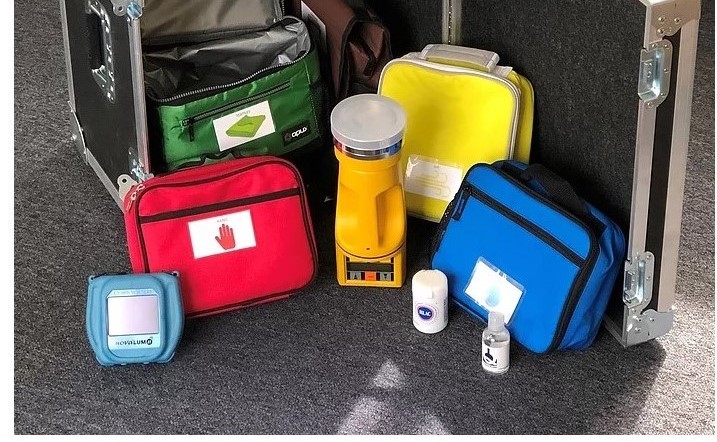
The Healthcare Laundry Accreditation Council (HLAC) recently announced final-phase testing of its new HLAC Laundry Process Monitoring ToolKit(TM) (PMTK). The toolkit is a new innovation in laundry testing and process analysis that is capable of recovering accurate representations of viable organisms (bioburden) on healthcare textiles; and quantifying the sources of potential environmental contamination on textiles that are known to come from air, hands, hard surfaces, and in water systems, according to a news release from HLAC.
“In simplified terms, our PMTK does for microorganism identification what the Hubble Telescope does for astronomy,” said Gregory Gicewicz, who heads the committee developing the toolkit on behalf of HLAC, a nonprofit organization that inspects and accredits laundries processing textiles for hospitals, nursing homes and other healthcare facilities. Gicewicz is president of Sterile Surgical Systems of Tumwater, WA, and was one of the early adopters who volunteered to pilot the toolkit concept in their facilities. Other early adopters included HLAC board member Myles Noel, CEO of Central Ohio Medical Textiles (COMTEX), Columbus, Ohio; and Judy Reino, president of Reino Linen Service in Gibsonburg, Ohio.
HLAC views PMTK as a logical outgrowth of its professional expertise and, in developing the toolkit, HLAC is responding to the challenge for operators to continually know how well their processes are performing and whether their standards are on target as originally intended.
Below HLAC shares experiences and observations from early adopters, Gicewicz, Noel and Reino:
Overall Observations
“What we immediately learned from the experience is that you cannot assume the level of cleanliness of any surface just because of its location in the plant,” Reino said. “The testing helped us to identify those areas that would benefit from additional attention and, as such, these areas were then placed on an accelerated cleaning schedule. Furthermore, our cleaning schedule was then expanded to include additional time and testing in order to make sure these surfaces remained clean.”
Noel says, “PMTK made us aware of the areas in the plant that impact the quality of our linen output that we took for granted. By testing and reviewing the cleanliness of water, air, hard surfaces, textiles and staff hand hygiene, we discovered the link between our success and these elements.”
Ordering, Delivery and Instructions
Upon ordering from HLAC, the toolkit is delivered to the laundry in the form of a protective case containing five sampling kits. It comes with everything a laundry needs to perform effective, consistent and reliable process monitoring. Each self-contained sampling kit is color-coded for ease of use.
“The PMTK was received in perfect order with instructions on how to use it and proceed with the steps necessary for us to evaluate and improve our processes,” Noel said. “The instructions were clear and easy to follow.”
The Testing Process
Monitoring comprises five areas (linen, surfaces, air, water and hands), each with multiple tests. HLAC suggests that it takes approximately 14 to 18 person hours to complete, whereupon the samples are returned to an independent lab for analysis using validated recovery procedures. The monitoring can be performed at the laundry’s convenience – one time, quarterly, semiannually, etc.
“We dedicated a two-person team to the testing process,” Reino said. “As such, the testing was easy and took two full days to complete.”
Noel commented, “For us, the testing took the better part of six hours with most aspects of the testing completed by a customer relations staff member with little assistance. With a little practice, we believe these tests will become routine and likely could be completed within a single morning.”
Applying the Results
Test results, which are kept confidential, are communicated directly to the laundry. With the data in hand, the laundry may adjust accordingly the effectiveness of its overall plant hygiene, wash and hand-hygiene processes. This includes general comparative data for evaluating before and after conditions of cleaning processes, and the effects of process modifications and/or system improvements. It also provides trending data over time (e.g., reasons for process variability) for determining process consistency and identifying opportunities for improvements, according to the release.
Gicewicz noted changes made to several processes. “Our tunnel press discharge conveyor showed up with high levels of contamination every time we performed surface testing using the toolkit,” Gicewicz said. “Our press water tank also showed high levels of contamination when we tested the water. Thus, we changed the frequency, method, and chemicals used to disinfect the tank. Subsequent testing showed the press discharge conveyor and the press tank water had dramatically reduced and acceptable levels of contamination.”
COMTEX has also implemented several changes since using PMTK said Noel. Most notably discussing and demonstrating proper hand washing at the start of every company meeting; developing an automated conveyor belt sanitizing device and scheduling regular cleaning including regular hard surface (ATP) of conveyors; and conducting a thorough emptying and chemical cleaning of the tunnel washers, especially the double drum sections.
“We intend to monitor the results each time we perform PMTK testing, and challenge ourselves to continually improve in all areas,” Noel said. “The baseline uncovered from this early adoption helped us to establish a point from which to move forward and improve from in all areas. We are looking forward to development of a database to be able to compare our results to the collective results of all laundries using PMTK. This, as a valuable method to help us improve all our processes.”













